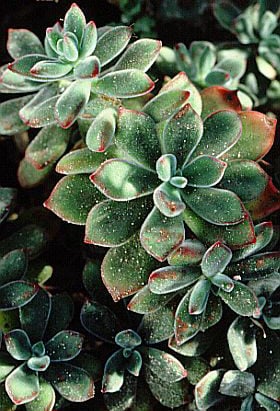Size
Ultimate height
0.1–0.5 metresTime to ultimate height
5–10 yearsUltimate spread
0.1–0.5 metresGrowing conditions
Moisture
Well–drainedpH
Acid, Alkaline, NeutralColour & scent
| Stem | Flower | Foliage | Fruit | |
| Spring | Grey Silver Red White | |||
|---|---|---|---|---|
| Summer | Grey Silver Red White | |||
| Autumn | Grey Silver Red White | |||
| Winter | Red Yellow | Grey Silver Red White |
Position
- Full sun
Aspect
South–facing or East–facing or North–facing
Exposure
Sheltered Hardiness
H2Botanical details
- Family
- Crassulaceae
- Native to GB / Ireland
- No
- Foliage
- Evergreen
- Habit
- Bushy
- Genus
Echeveria can be evergreen succulent perennials or subshrubs with rosettes of colourful, fleshy leaves and racemes or panicles of urn-shaped flowers
- Name status
Correct
- Plant range
- S Mexico
How to grow
Cultivation
Grow under glass in a standard cactus compost, in full light. Provide low humidity. Water freely when in growth and keep just moist at other times. Apply a dilute low nitrogen fertilizer fortnightly during late spring and summer. Keep almost dry in the winter. Stand plants outside during the summer months. See Echeveria and houseplant cacti and succulent cultivation for further advice
Propagation
Propagate by seed sown at 15 - 18°C in early spring or stem or leaf cuttings in spring or early summer. Separate offsets in spring
Suggested planting locations and garden types
- Patio and container plants
- Low Maintenance
Pruning
No pruning required
Pests
May be susceptible to mealybugs, vine weevil and aphids
Diseases
Generally disease-free
Get involved
The Royal Horticultural Society is the UK’s leading gardening charity. We aim to enrich everyone’s life through plants, and make the UK a greener and more beautiful place.
